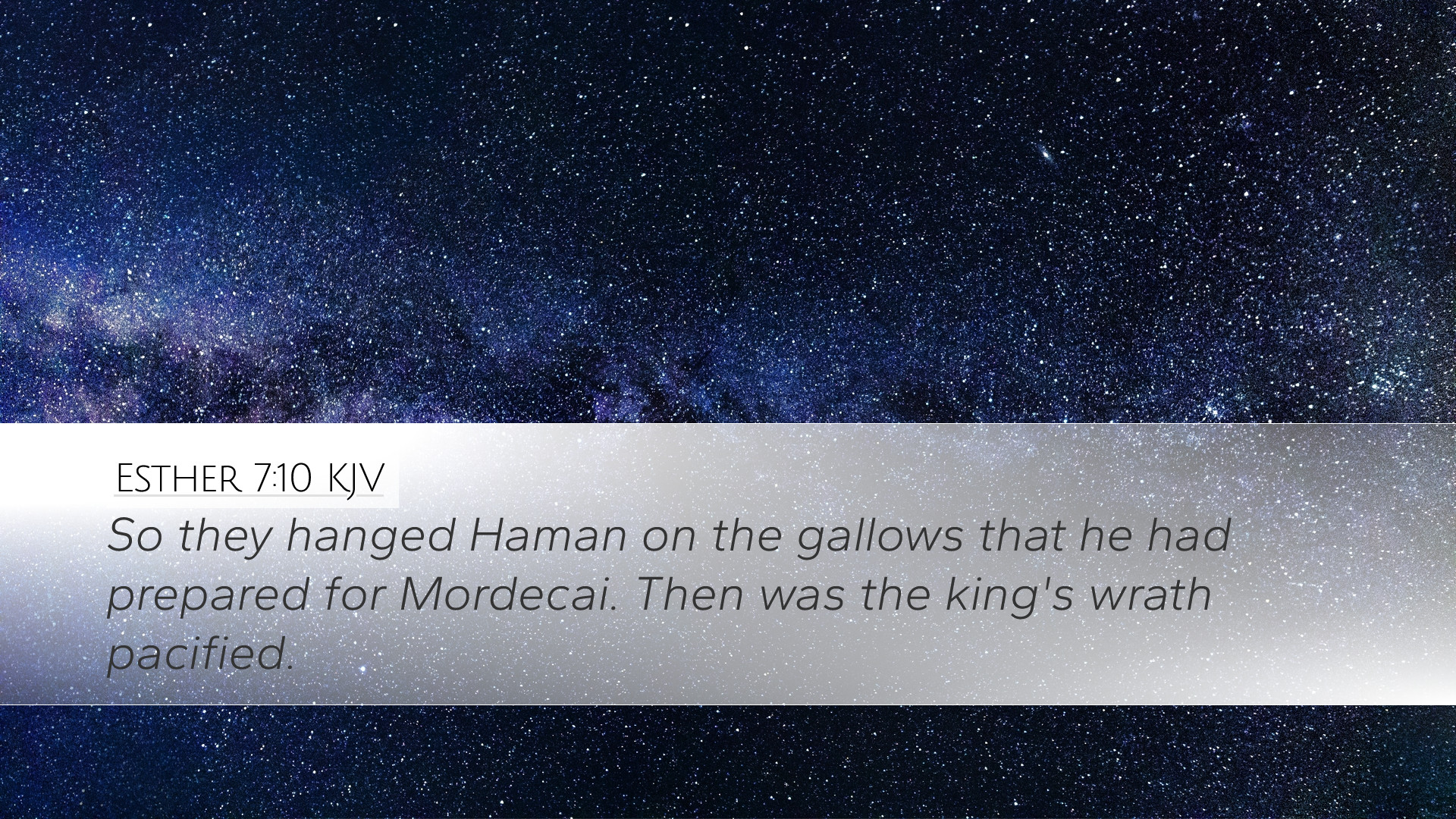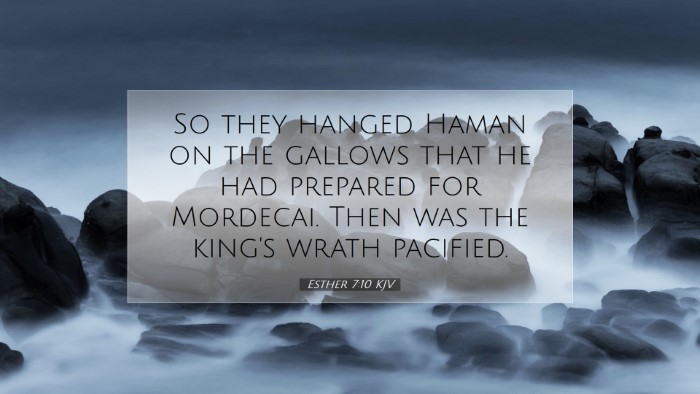Old Testament
Genesis Exodus Leviticus Numbers Deuteronomy Joshua Judges Ruth 1 Samuel 2 Samuel 1 Kings 2 Kings 1 Chronicles 2 Chronicles Ezra Nehemiah Esther Job Psalms Proverbs Ecclesiastes Song of Solomon Isaiah Jeremiah Lamentations Ezekiel Daniel Hosea Joel Amos Obadiah Jonah Micah Nahum Habakkuk Zephaniah Haggai Zechariah MalachiEsther 7:10
Esther 7:10 KJV
So they hanged Haman on the gallows that he had prepared for Mordecai. Then was the king's wrath pacified.
Esther 7:10 Bible Commentary
Commentary on Esther 7:10
Esther 7:10 states, "So they hanged Haman on the gallows that he had prepared for Mordecai. Then was the king’s wrath pacified." This verse encapsulates a dramatic turning point in the Book of Esther, where the fate of Haman and Mordecai culminates in divine justice and reversal of fortunes.
Contextual Background
The Book of Esther describes the plight of the Jewish people in Persia, particularly focusing on Esther, a Jewish queen, and her cousin Mordecai. Haman, a high-ranking official, harbors a deep animosity towards Mordecai, leading to a plot to exterminate the Jews. The tension culminates in Esther’s courageous intercession and the eventual downfall of Haman.
Analysis of Key Elements
Haman’s Gallows
The gallows that Haman prepared for Mordecai symbolize the evil intentions of the enemy against God’s people. According to Matthew Henry, there is a profound irony in Haman's demise; the instrument he intended for Mordecai's destruction becomes the means of his own execution. This serves as a powerful reminder of the biblical principle that those who plot evil will ultimately fall into their own traps.
The Role of Divine Justice
Albert Barnes emphasizes that the execution of Haman serves as a demonstration of divine justice. God intervenes at a critical moment, turning the tables on Haman, who represents the embodiment of pride and treachery against God’s chosen people. This moment reinforces the theological theme that God is sovereign and will vindicate the righteous, even when the circumstances seem overwhelmingly dire.
The King's Wrath Pacified
The concluding phrase, "Then was the king’s wrath pacified," is crucial. Adam Clarke notes that the resolution of the king's anger reflects the restoration of order in the realm. Haman's execution not only addresses the immediate threat to Esther and her people but also serves to appease the king's fury, showcasing that justice must be served for peace to be restored.
Theological Implications
This verse presents numerous theological themes that are meaningful for pastors, students, and scholars:
- Justice and Retribution: The account illustrates the biblical truth that God will enact justice. This theme can be applied doctrinally, as believers find hope in the promise that God will right all wrongs.
- Divine Sovereignty: The events suggest that God orchestrates the affairs of people, even using seemingly mundane moments to fulfill His divine will. This calls theological students to examine how divine providence is evident in their own lives.
- Courage and Advocacy: Esther's bravery reminds individuals of the importance of standing up for what is right, despite personal risk. This is a crucial lesson for modern-day Christians facing moral choices.
Practical Applications
From this passage, several applications can be drawn:
- Trust in God: Believers are encouraged to trust in God’s plan, knowing that He sees the underlying motives of hearts, much like He did within the plot against Mordecai.
- Exercise of Justice: The narrative encourages church leaders to promote justice and righteousness in their communities.
- Empowerment of the Oppressed: Esther's story can serve as an inspiring model for empowering those who are marginalized and oppressed, urging believers to advocate for justice.
Conclusion
Esther 7:10 is more than a historical recounting of events; it serves as a powerful reminder of God's sovereignty over human affairs, the ultimate victory of good over evil, and the call for believers to act with righteousness and courage. The fall of Haman serves as a caution against pride and enmity toward God’s people while offering hope that God will fulfill His promises to protect and deliver His own.


